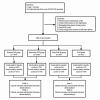The clinical value of short-term insemination: a retrospective analysis of 3496 patients
- PMID: 39810090
- PMCID: PMC11731415
- DOI: 10.1186/s12884-025-07151-9
The clinical value of short-term insemination: a retrospective analysis of 3496 patients
Abstract
Background: The safety and effectiveness of short-term insemination remain a subject of controversy. This study aims to investigate the impact of short-term insemination on both embryo quality and pregnancy outcomes and whether it is necessary to apply short-term insemination to all patients underwent in vitro fertilization (IVF).
Methods: A retrospective analysis was conducted on 3,496 patients from two centers over the period January 2016 to December 2022. Of these, 1307 patients underwent IVF, 1656 patients were treated with short-term IVF, 166 patients received early rescue intracytoplasmic sperm injection (R-ICSI) and 367 patients were treated with ICSI. The clinical and neonatal outcomes were compared between the two groups.
Results: The rate of high-quality embryos was significantly lower in the short-term IVF group compared to the routine IVF group (59.89% vs. 68.16%) (P = 0.000), the rate of blastocyst formation was significantly lower in the short-term IVF group compared to the routine IVF group (44.99% vs. 61.34%) (P = 0.000). There were no significant differences in clinical outcomes or neonatal outcomes between the two groups, irrespective of whether fresh or frozen embryos were used (both P > 0.05). The incidence of ≥ 3PN demonstrated no significant difference between the early R-ICSI and ICSI groups (1.04% vs. 0.66%) (P = 0.114), furthermore, the clinical outcomes were similar in both groups, for both fresh and frozen embryos (both P > 0.05).
Conclusions: For patients with primary fertility, short-term IVF combined with early R-ICSI can effectively prevent potential low fertilization or fertilization failure, reduce the risk of patients with no transferable embryo, avoid the waste of resources and had no adverse effects on neonatal outcomes. However, short-term IVF reduced the oocytes utilization rate in one single oocyte pick-up cycle, for patients with no risk factors for fertilization failure, the overnight fertilization is still one of the most important ways of insemination worthy of affirmation.
Trial registration: NA.
Keywords: Early rescue intracytoplasmic sperm injection; Embryo quality; Pregnancy outcome; Short-term in vitro fertilization.
© 2025. The Author(s).
Conflict of interest statement
Declarations. Ethics approval and consent to participate: All method was conducted according the ethical standards of the declaration Helsinki. The Reproductive Medicine Ethics Committee of the Second Affiliated Hospital of Nanjing Medical University reviewed and approved this study. Informed consent was obtained from all of the participants. Consent for publication: Not applicable. Competing interests: The authors declare no competing interests.
Figures
Similar articles
-
Day after rescue ICSI: eliminating total fertilization failure after conventional IVF with high live birth rates following cryopreserved blastocyst transfer.Hum Reprod. 2023 Jul 5;38(7):1277-1283. doi: 10.1093/humrep/dead097. Hum Reprod. 2023. PMID: 37208859
-
Livebirth rates are influenced by an interaction between male and female partners' age: analysis of 59 951 fresh IVF/ICSI cycles with and without male infertility.Hum Reprod. 2024 Nov 1;39(11):2491-2500. doi: 10.1093/humrep/deae198. Hum Reprod. 2024. PMID: 39241250 Free PMC article.
-
Is intracytoplasmic sperm (ICSI) better than traditional in vitro fertilization (IVF): confirmation of higher blastocyst rates per oocyte using a split insemination design.J Assist Reprod Genet. 2020 Jul;37(7):1661-1667. doi: 10.1007/s10815-020-01819-1. Epub 2020 May 20. J Assist Reprod Genet. 2020. PMID: 32436048 Free PMC article.
-
Should rescue ICSI be re-evaluated considering the deferred transfer of cryopreserved embryos in in-vitro fertilization cycles? A systematic review and meta-analysis.Reprod Biol Endocrinol. 2021 Aug 4;19(1):121. doi: 10.1186/s12958-021-00784-3. Reprod Biol Endocrinol. 2021. PMID: 34348713 Free PMC article.
-
Fresh versus elective frozen embryo transfer in IVF/ICSI cycles: a systematic review and meta-analysis of reproductive outcomes.Hum Reprod Update. 2019 Jan 1;25(1):2-14. doi: 10.1093/humupd/dmy033. Hum Reprod Update. 2019. PMID: 30388233
References
-
- Qi Z, Liu Y, Yang H, Yang X, Wang H, Liu B, et al. Protective role of m(6)a binding protein YTHDC2 on CCNB2 in manganese-induced spermatogenesis dysfunction. Chemico-Biol Interact. 2022;351:109754. - PubMed
-
- Zhou Y, Gu Z, Liu C, Yang S, Ma X, Chen Q, et al. A polymeric nanobeacon for monitoring the fluctuation of Hydrogen Polysulfides during fertilization and Embryonic Development. Angewandte Chemie (International ed English). 2022;61(16):e202114504. - PubMed
MeSH terms
LinkOut - more resources
Full Text Sources


